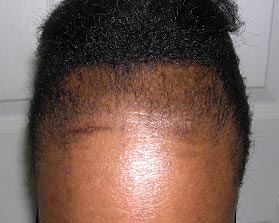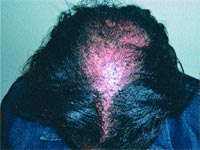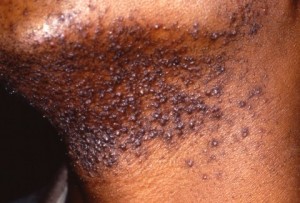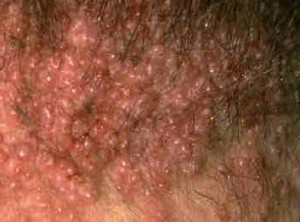African Hair Disorders Dallas
African-Americans experience a unique set of problems with their hair owing to the nature of African hair and skin as well as to different styling methods that can predispose to problems as well. The kink and curl of African hair can lead to ingrown hairs and related scarring (to be discussed). Also, African hair tends to be typically very dry with the cuticle weathering much more easily. Frequent shampooing of African hair can lead to excessive dryness and brittleness such that about half of African-American women shampoo their hair weekly and another third every other week. Shampoos with anionic agents are particularly drying to the hair. African-American men who tend to shave their hair very closely especially along the posterior, occipital hairline can be prone to ingrown hairs that lead to keloid formation.
African American Hair Loss Causes
 Traction Folliculitis and Traction Alopecia
Traction Folliculitis and Traction Alopecia
Tight braiding practices can lead to traction folliculitis and traction alopecia, where over time the condition is irreversible. Tight braiding and use of hot oils can also predispose toward tinea capitis infections, particularly in young prepubescent African-American girls. The practice of hot combing has led to scalp and hair injuries. This practice has also been associated with follicular degeneration syndrome (to be discussed). An estimated 45 to 80% of African-American women tend to use relaxers (chemical straighteners) that can lead to scalp burns and hair damage. However, permanent hair loss is unlikely with relaxers.
 Follicular Degeneration Syndrome
Follicular Degeneration Syndrome
This condition has also been discussed in the scarring (cicatricial) alopecia section of this website. Follicular degeneration syndrome (FDS) was initially referred to as hot-comb alopecia given the thought that hair loss that occurred in the vertex and midscalp in African-Americans was believed to be related to the use of hot combs. However, Sperling and Sau found that clinical scarring alopecia was found in women who did not use or infrequently used hot combs. They also found FDS in African-American men who did not use any chemical straighteners. If a hot comb or other extreme hairstyling method is used extensively, modification should be undertaken to minimize the irreversible scarring that can occur.
 Pseudofolliculitis Barbae and Folliculitis Barbae
Pseudofolliculitis Barbae and Folliculitis Barbae
Pseudofolliculitis barbae arises in shaved areas in individuals with kinky or curly hair and consists of papules and pustules that occur in and around the beard follicles. 45 to 83 percent of African-American men exhibit pseudofolliculitis barbae with shaving. Severe scarring can result from this disorder.
Extrafollicular penetration occurs when the hair shaft with its sharp point after shaving invaginates into the skin 1 to 2 mm from the follicular opening. Transfollicular penetration occurs when the skin is pulled taut during shaving and the hair follicle retracts back to eventually stab the skin through a different opening upon exiting.
The extrafollicular variety is the harder of the two to manage and may require wearing a beard as the only definitive cure. Depilatories (discussed in the hypertrichosis section) can be effective in controlling pseudofolliculities barbae. Kligman and Mills found that 0.05% topical retinoic acid could in early cases show improvement after 3 to 4 weeks of treatment. A mild corticosteroid may need to be added to minimize the irritative effects of topical retinoic acid.
Plucking hair can be a very important reason for the rise of pseudofolliculitis barbae and should not be allowed. Electrolysis or laser hair removal may be important adjuncts in women and in men who are willing to not be able to grow a beard. Vaniqa (eflornithine cream 13.9%) can also help by slowing the hair growth in hirsutism when topically applied.
Some men who shave do get a true folliculitis especially when using a dull razor. The nape of the neck can be another area prone to folliculitis when shaved closely by a barber. Avoiding contaminated equipment and changing razor blades more frequently can minimize this problem. Topical and/or oral antibiotics may be necessary to combat this condition and to minimize recurrences.
 Folliculitis Keloidis
Folliculitis Keloidis
African-American men who shave the nape of their neck with a razor or a “liner” can create a folliculitis or pseudofolliculitis, leading to keloidal papules and plaques over time. There has been an increase in this condition given the closely-shaved hairstyles that today are in vogue in African-American men. Hair should be left 2 to 3 mm long in the back to minimize this problem. When a folliculitis arises, topical or systemic antibiotics should be used to prevent the infection from turning into a keloid. Tetracycline 0.5 to 1 gram, doxycycline 100 to 200 mg, minocycline 100 mg, and erythromycin 0.5 to 1 gram per day have been used. Application of liquid nitrogen on these lesions with a cotton-tipped applicator has been used to limit early lesions but can risk depigmentation. Injected corticosteroids can also be used to treat this problem but requires time and patience to achieve great results.
Dissecting Cellulitis
African-American males can exhibit a difficult to manage condition of dissecting cellulitis (perifolliculitis capitis abscedens et suffodiens) in which multiple large abscesses, chronic draining sinuses, and scarring alopecia can arise. Lesions can coalesce to form giant carbuncles with cultures that can grow out staph. aureus. Systemic antibiotics, systemic corticosteroids and extensive surgical removal have been used with varying success. Oral isotretinoin (Accutane) has been reportedly effective. Dapsone 100 mg twice to three times daily has also been helpful. A combination of ciprofloxacin or cephalexin 500 mg twice daily combined with rifampin 600 mg once a day prescribed over a two-week course with another two-week course as needed has proven useful in treating this condition. Laser hair removal and incision/drainage have also been other methods to treat this condition.




